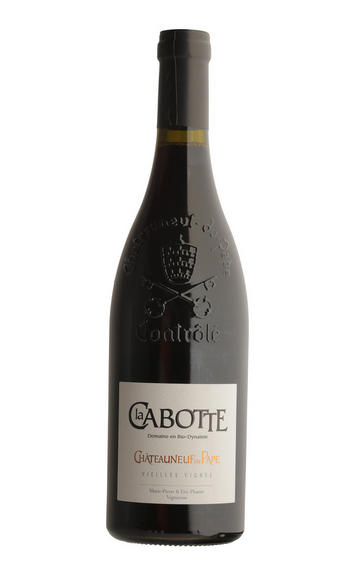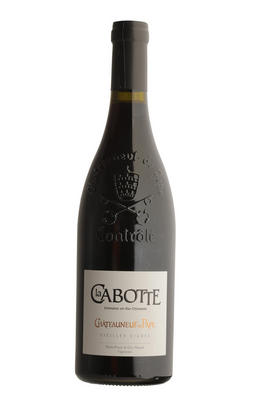
2022 Châteauneuf-du-Pape Rouge, Vieilles Vignes, Domaine la Cabotte, Rhône

About this WINE

Domaine la Cabotte
Purchased in 1981 and owned by the Plumet family ever since, the domaine has grown from 10 to 30 hectares of vines, with an additional 12 hectares coming on-stream this year, and 1.5 hectares in Châteauneuf-du-Pape. It is certified organic and farmed biodynamically. The mainly limestone and sand soils of the plateau of the Massif d’Uchaux are very poor in nutrients. This enables them to produce wines of real finesse and elegance in comparison to those from neighbouring appellations. Eric and Marie-Pierre Plumet believe that managing the environment around the vineyard is essential for a site’s health – from maintaining their 15 hectares of forest, to regulating water and the influence of wind, to promoting biodiversity. Son Etienne has been part of the team here for the past few years and is taking biodynamic innovations forward with his parents. Across the board, their wines are pure, mineral and fine.
The 2021 vintage was just as challenging for this domaine as it was for their neighbours, however, here Etienne talks of how their biodynamic approach saved them. He states that, after spraying vines that were 40% frosted with a valerian tea-infusion, the grapes recovered, leaving only 5% final damage. The freshness of 2021 is hugely complementary to Cabotte’s beautiful purity of style. These are wines with great ageing potential, especially La Sauvageonne. Etienne recently tasted a vertical of this wine from the last decade and each one was fresh as a daisy. The Colline Blanc is from the warmer and more fruit-forward 2022 vintage which Eric and Marie-Pierre describe as “one beautiful vintage in the making”.

Châteauneuf-du-Pape
The most celebrated village of the Southern Rhône, Châteauneuf-du-Pape is the birthplace of the now indispensable French Appellation d’Origine Contrôlée system – imperfect though it may be. Compared to the Northern Rhône, the vineyards here are relatively flat and often feature the iconic galet pebbles – the precise benefits of which are a source of much debate. Minimum alcohol levels required by the AOC are the highest in France, but at 12.5% it is well below the natural generosity of Grenache, which only achieves its full aromatic potential when it is fully ripe and laden with the resultant high sugars. Syrah and Mourvèdre contribute the other defining elements in the blend, adding pepper, savoury spice and structure to the decadent Grenache. There are a further 10 permitted red grape varieties which can be used to adjust the “seasoning”. Of the five white varieties permitted, it is Grenache Noir’s sibling – predictably perhaps – Grenache Blanc, which dominates, though Roussanne shows a great deal of promise when handled well, notably at Château de Beaucastel.

Southern Rhône Blend
The vast majority of wines from the Southern Rhône are blends. There are 5 main black varieties, although others are used and the most famous wine of the region, Châteauneuf du Pape, can be made from as many as 13 different varieties. Grenache is the most important grape in the southern Rhône - it contributes alcohol, warmth and gentle juicy fruit and is an ideal base wine in the blend. Plantings of Syrah in the southern Rhône have risen dramatically in the last decade and it is an increasingly important component in blends. It rarely attains the heights that it does in the North but adds colour, backbone, tannins and soft ripe fruit to the blend.
The much-maligned Carignan has been on the retreat recently but is still included in many blends - the best old vines can add colour, body and spicy fruits. Cinsault is also backtracking but, if yields are restricted, can produce moderately well-coloured wines adding pleasant-light fruit to red and rosé blends. Finally, Mourvèdre, a grape from Bandol on the Mediterranean coast, has recently become an increasingly significant component of Southern Rhône blends - it often struggles to ripen fully but can add acidity, ripe spicy berry fruits and hints of tobacco to blends.


Buying options
Add to wishlist
Description
The aromas of Cabotte’s incredible, old-vine cuvée show the darker fruited, garrigue-herbal, old vine side of Châteauneuf-du-Pape. The nose is fresh and bright with so much wet stone energy. The palate is wonderfully poised with ultra-fine fruit combining seamlessly with powdery tannins. This is lovely and harmonious with a beautifully fresh finish.
Drink 2024 - 2040
Berry Bros. & Rudd
wine at a glance
Delivery and quality guarantee